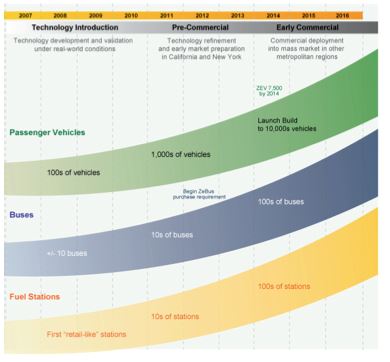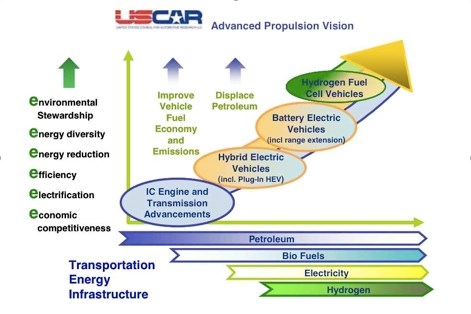Evolutionary timeline for FCVs
When will fuel cell vehicles (FCVs) be sold at production levels? Ultimately, many factors will affect that timeline, including fuel efficiency standards, the price of gasoline, commitment by automakers to produce them at affordable rates, and government funding for additional R&D.
When will fuel cell vehicles (FCVs) be sold at production levels?
Ultimately, many factors will affect that timeline, including fuel efficiency standards, the price of gasoline, commitment by automakers to produce them at affordable rates, and government funding for additional R&D — not only for onboard fuel cell systems but the hydrogen (H2) refueling infrastructure to support them.
In a July 2009 statement, the U.S. Council for Automotive Research (USCAR), founded in 1992 to foster collaboration on advanced technologies between General Motors, Ford and Chrysler, envisioned commercial hydrogen FCVs near the end of a 15-year evolutionary process: “Because profitable high-volume deployment of FCVs depends on significant progress in multiple technologies both on and off the vehicle, the USCAR OEMs have made deployment of hybrid, plug-in hybrid, and various forms of electric vehicles a near-term focus. Most of the core technologies (battery, electric-drive systems, system controls) of these ‘electrified’ products will flow directly to fuel cell vehicles. The OEMs and their competitors are continuing their internal work on hydrogen storage and fuel cell propulsion systems, despite the unprecedented downturn in the industry.” Results of this internal work over the past year include these achievements within the global FCV test fleet:
- Toyota’s Highlander advanced fuel cell hybrid vehicle achieved an estimated range of 431 miles on a single tank of compressed H2 gas and an average fuel efficiency of 68.3 miles/kg.
- Daimler unveiled its Mercedes Benz B-class F-Cell FCV with a 40 percent smaller stack providing 30 percent more power and consuming nearly 20 percent less H2.
- GM surpassed a million miles of testing with its Chevrolet Equinox FCVs.
- Kia Motors and parent company Hyundai announced plans to launch a fuel cell model in 2012, based on successful testing of its Borrego SUV, under its “Eco Dynamics” sub-brand.
- Honda’s Clarity FCX was named 2009 World Green Car at the New York International Auto Show. The OEM claims that the Clarity FCX is the world’s first dedicated-platform H2 FCV; the vehicle is powered by Honda’s vertical flow stack (or V-Flow).
- Nissan is beginning cold-weather testing of its 130 kW fuel cell stack, which achieves a 35 percent cost reduction, compared to previous stacks, with twice the power density.
- Volvo Group Global and partners will invest $25 million (USD) to implement reformer-based fuel cell technology to speed commercialization of FCVs.
- Ford Motor Co. announced its development of an intelligent vehicle-to-grid communications and control system that the company calls “an important step in the journey toward widespread commercialization of electric vehicles” (which could include FCVs).
Formed in 1999, the California Fuel Cell Partnership (CaFCP, West Sacramento, Calif.) issued its vision for the rollout of FCVs and a hydrogen infrastructure in July 2008 (see timeline graphic, at right). Member companies Daimler, Chrysler, Ford, GM, Honda, Hyundai, Nissan, Volkswagen, and Toyota are now entering the third phase of CaFCP activities that will demonstrate the real-world feasibility of FCVs. In Phase I (1999-2003), industry members proved the technical viability of FCVs and fueling stations through their own on-road operations. During Phase II (2004-2007), automakers and energy companies launched demonstration programs with customers, operating more than 200 FCVs and 25 fueling stations. In Phase III, emphasis is on the transition from demonstration projects to pilot commercial projects with larger numbers of vehicles, retail-like H2 fueling stations and individual customers driving FCVs as part of their daily lives.
Internationally, research programs continue to be launched to make the FCV-to-hydrogen-infrastructure connection. In August, Tokyo Gas Co. and 11 other Japanese companies (including automakers) formed an alliance to conduct field trials with dozens of H2 stations across Japan, in urban areas as well as on highways. An alliance statement explains that “by using the oil companies’ hydrogen production facilities and the pipelines of the gas companies, the group will research ways to transport the fuel to filling stations in a stable manner at low cost.”
On Sept. 12, a Letter of Understanding was published announcing a H2 mobility plan for FCV commercialization worldwide among OEM participants Daimler AG, Ford, GM, Honda, Hyundai, Kia, Toyota, Renault SA and Nissan. The letter offers strong support for continued market introduction of FCVs and for construction of a H2 infrastructure. “Current demonstration projects involving fuel retail companies, utility providers, and engineering companies have shown that the production, storage, transportation and deployment of efficient equipment for hydrogen as a fuel are technically feasible. The alliance companies have built up remarkable know-how in fuel cell technology and thus, the signing of this letter marks a major step towards the serial production of emission-free vehicles.”
This past October, a coalition of the European Union, European industry and the European research community announced plans to invest $1.47 billion over six years in fuel cells and H2 research, technological development, and demonstration of a mass-market rollout of these technologies by 2020. Key goals of this public/private Joint Technology Initiative (JTI), which involves more than 100 private companies and research facilities, include pooling resources to overcome barriers to H2 fuel cell deployment, reducing time to market, and reaching large-scale commercialization decisions in the 2015-2020 timeframe. A JTI stakeholders general assembly meeting will take place Oct. 26-27, this year, in Brussels, Belgium.
In August, after several months of uncertainty regarding continued support of U.S. Department of Energy (DoE) funding for advanced fuel cell vehicle development, the U.S. House of Representatives passed H.R. 3246, the Advanced Vehicle Technology Act of 2009. The bill provides $550 million a year, increasing over five years, “to strengthen and reauthorize the DoE vehicle technologies program.” In a Sept. 22 response statement from the American Chemistry Council (ACC) regarding this bill’s passage, ACC president and CEO, Cal Dooley, makes the point that “ACC member companies are working with their automotive manufacturing partners to create innovative vehicle components from plastic and composite materials that reduce weight, lower emissions, and increase fuel efficiency, without compromising passenger safety.”
Larry Burns, GM’s outgoing R&D chief with 40 years’ service and called “Mr. Environment” for his efforts to champion fuel cell technology, commented on GM’s Fastlane blog that “the question is not batteries vs. fuel cells or fuel cells vs. bio-fuels. We need all three. It is important to recognize that first generation technology in the auto industry is usually costly versus the mature alternatives that it competes with. The key is to kick off a generation-by-generation learning cycle that allows the new technology to reach its mature, high-volume potential.” [Editors note: GM’s Fastlane blog no longer exists but a compilation of articles from the blog can be found here].
Related Content
Bcomp ampliTex makes appearance in Cupra EV Cup Bucket seats
The entire Cupra Born VZ line-up features all-natural fiber front seats that highlight functionality, aesthetics and reduced CO2 emissions.
Read MoreAptera joins forces with C.P.C. Group to accelerate solar EV production
Specialized composite bodies are being produced in Modena, Italy, for Aptera’s BinC vehicle, enabling eventual manufacturing ramp-up of 40 vehicles/day to meet demand targets.
Read MoreHRC facilitates development of Karma Automotive ultra-luxury EV
Low-density GF-SMC decklids, fenders and headlamp brackets will be provided for the GS-6 EV model to achieve weight reduction and higher performance.
Read MoreSeat frame demonstrates next-generation autocomposites design
Light weight, simplified/cost-effective manufacturing, passenger comfort and safety informed materials and process innovations and won awards for the 2022 Toyota Tundra‘s second-row seat frame.
Read MoreRead Next
Developing bonded composite repair for ships, offshore units
Bureau Veritas and industry partners issue guidelines and pave the way for certification via StrengthBond Offshore project.
Read MoreVIDEO: High-volume processing for fiberglass components
Cannon Ergos, a company specializing in high-ton presses and equipment for composites fabrication and plastics processing, displayed automotive and industrial components at CAMX 2024.
Read MoreAll-recycled, needle-punched nonwoven CFRP slashes carbon footprint of Formula 2 seat
Dallara and Tenowo collaborate to produce a race-ready Formula 2 seat using recycled carbon fiber, reducing CO2 emissions by 97.5% compared to virgin materials.
Read More












.jpg;maxWidth=300;quality=90)









